
From ancient times, Hasedera Temple has been a sacred place of the Kannon faith. The temple is called Hana no Mitera (Temple of Flowers) because various kinds of flowers bloom there throughout the year. The principal object of worship is one of the largest wooden Kannon statues in Japan, which stands about 10 meters tall. The place bustles with many worshipers who come to see the Kannon statue.
This article introduces one of the famous temples of Nara which also is famous for its amulet said to be good for beauty, something that makes many women happy.
Let's begin by visiting the temple precincts and learning more about Hasedera Temple's history
Hasedera Temple is the head temple of the Shingon Sect Buzan School which has about 3,000 temples nationwide. It is a historical temple which is also mentioned in such classics as the Genji Monogatari [Tale of Genji] and Makuranososhi [Pillow Book].
Recently, beautiful photos of Hasedera have been a topic of interest on Instagram. What is amazing is that a single monk takes, edits, and posts the photos by himself and has a following of more than 15,000, which would make even a professional production company envious!

Hasedera stands on the side of Mount Hatsuse overlooking the Hatsuse Highway that goes from Nara to Ise in Mie Prefecture. Since olden times this village hidden deep in the mountains has been a sacred place sung about in such ancient poems as the Komoriku no Hase and Manyoshu.
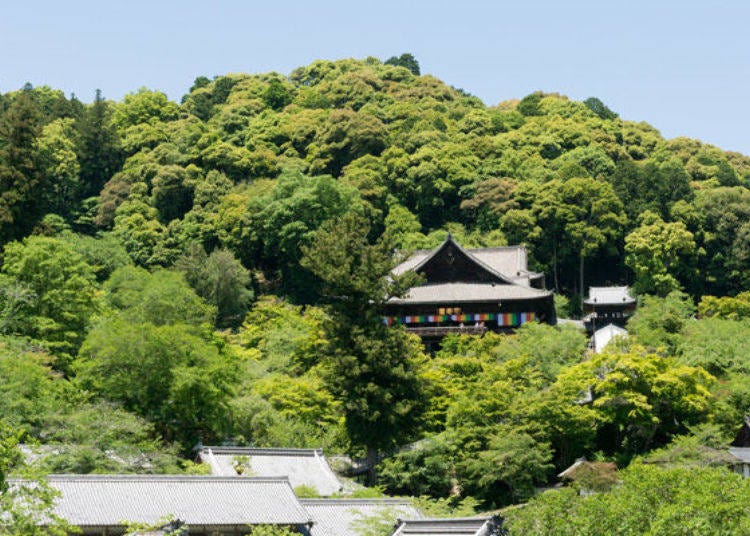
It was built in 686 on a hill to the west by Domyo Shonin [Saint Domyo] as a repository for the Doban Hokke Sessozu, a bronze plaque depicting a scene from the Lotus Sutra (a national treasure in the Senbutsu Taho Pagoda), for the Emperor Tenmu. In 727 during the Nara period, Tokudo Shonin, a disciple of Domyo Shonin, erected an eleven-faced Kannon Bodhisattva on a hill to the east at the request of Emperor Shomu.
It is said that Tokudo Shonin began the custom of making a pilgrimage to the 33 sites in Kinki and Gifu prefectures having sacred Kannon sites now referred to as the Pilgrimage to Saigoku [the west country] 33 Sacred Kannon Sites, thus resulting in Hasedera becoming the birthplace of the Kannon faith and its beginning as a sacred spot.
![▲Hasedera is also known for being the eighth fudasho [a temple where respects are paid] of the Saigoku 33 Sacred Kannon Sites](https://rimage.gnst.jp/livejapan.com/public/article/detail/a/20/00/a2000067/img/en/a2000067_parts_5cde173733b3a.jpg?20210204154316&q=80)
As you go along the stone-paved approach to the temple you will come to the Niomon [Deva Gate], the main gate of the Hasedera Temple. Two statues of Nio [Deva kings], one on each side, stand watch over the magnificent main single gate with its three openings and a hip-and-gable tiled roof.
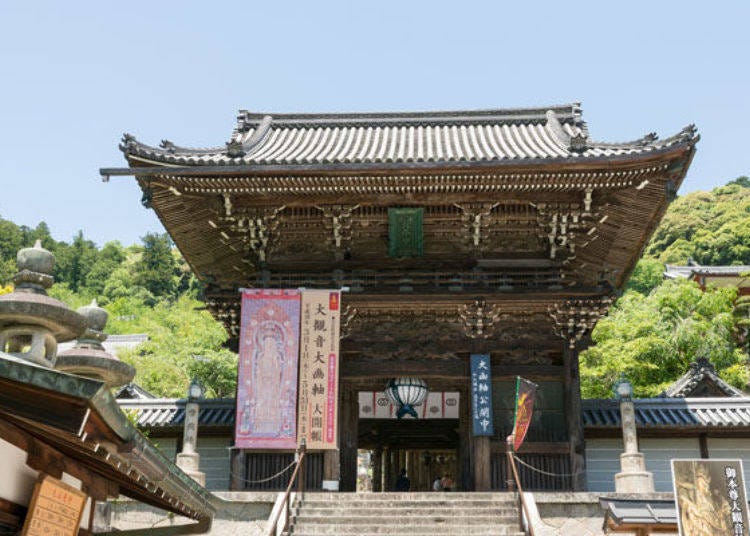
Passing through the gate you can see the roofed corridor called Noboriro which means “ascending corridor”. Legend has it that in 1039 a priest at the Kasuga Grand Shrine in Nara, Nobukiyo Nakatomi, had the Noboriro made as an offering expressing his gratitude to Hasedera for answering his prayers that his son be cured of an illness.
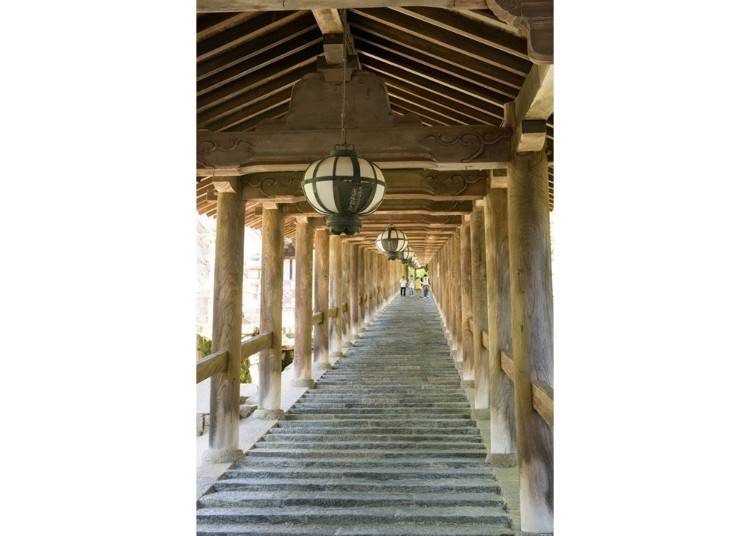
This long corridor is divided into three sections, upper, middle, and lower galleries, and there are a total of 399 steps in it. As can be seen in the photograph, the height of the steps in the lower gallery is low and as one proceeds up through the middle and upper galleries the height of the steps gradually increases. By the time you reach the 399th step at the top and arrive at the main hall you might feel a bit winded!
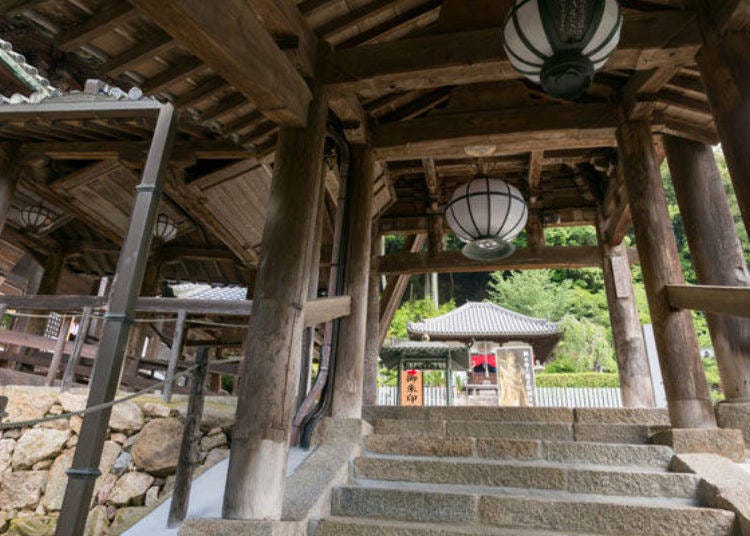
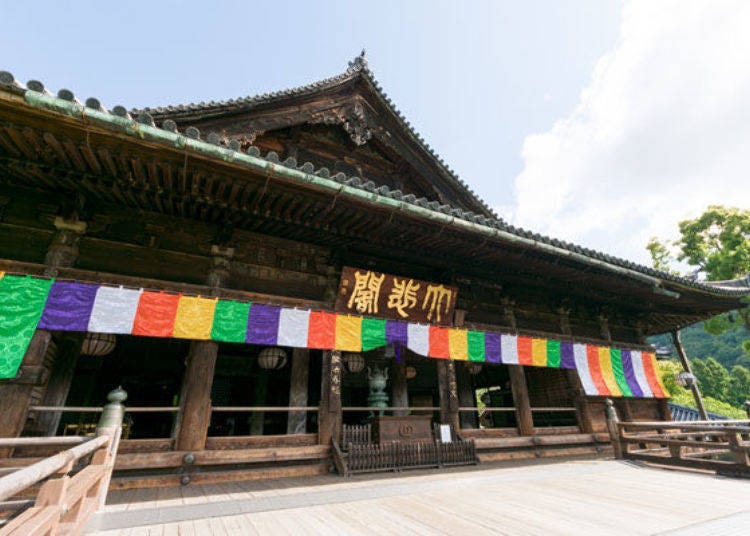
The main hall is built on a cliff and the overhanging construction method is said to be the same as that used in the construction of Kiyomizudera in Kyoto. The area in front of the main hall is built like a stage and the view from it is magnificent!
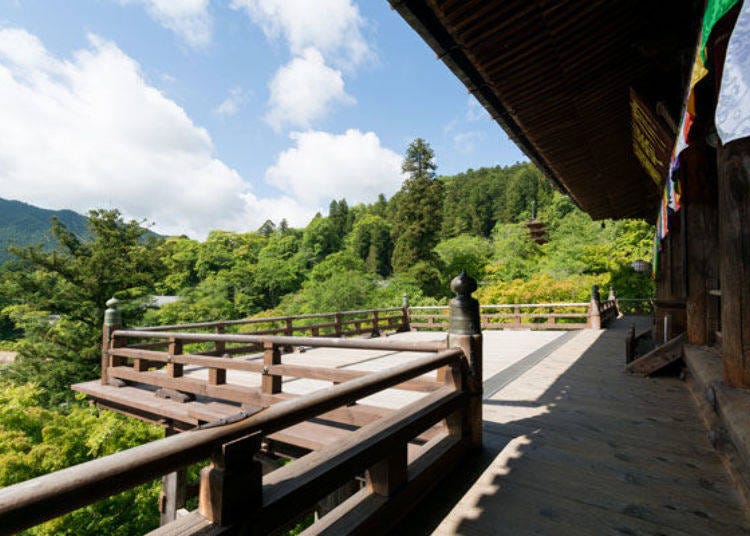
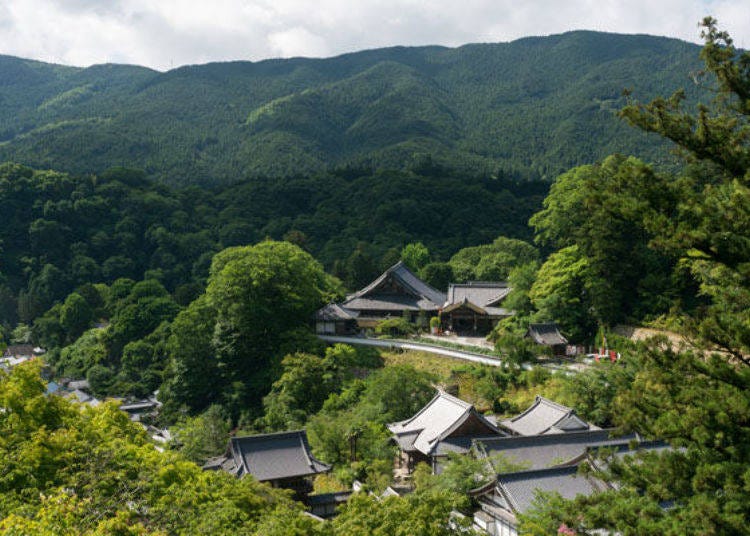
The main hall is in a style called "twin halls" because the Seido (inner sanctum) housing the eleven-faced Kannon Bodhisattva statue is connected to the Reido (outer sanctum). Between the Seido and the Reido there are stones laid in the earth floor and it is from these that the worshipers can worship Kannon.
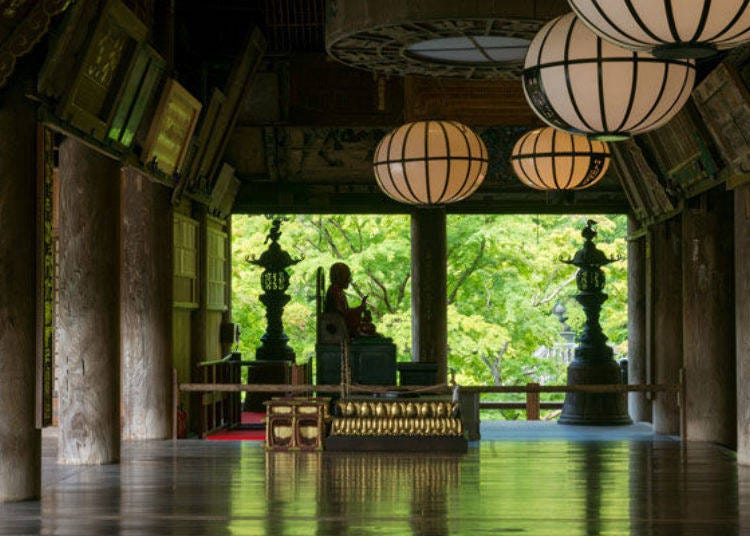
Come autumn and the reflections color the floor in autumn colors!
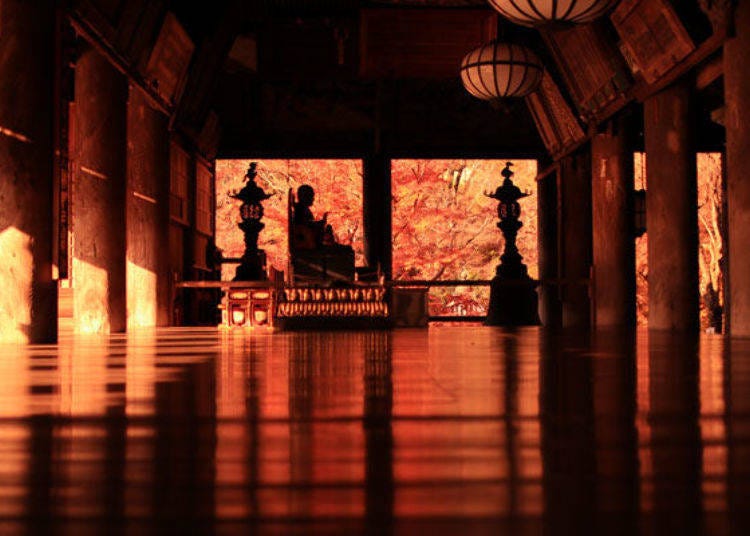
Every morning at 6:30 a.m. (7:00 a.m. October to March) several dozen monks chant sutras together in a morning service in the Reido and anyone may attend. In the clear air of early morning, the powerful chanting of sutras by the monks is most impressive. This is a refreshing and rewarding experience that I highly recommend you try at least once.

Become one with one of the largest Kannon [Goddess of Mercy] statues in Japan
The eleven-faced Kannon Bodhisattva, the main object of worship, is one of the largest Kannon statues in Japan boasting a height of 12.3 meters. Normally worship takes place in the space between the Seido and Reido, but twice a year, in spring and autumn, entry is permitted into the area which normally is off limits so that worshipers can directly touch the foot of the Kannon statue (please check the homepage for when those special times are).
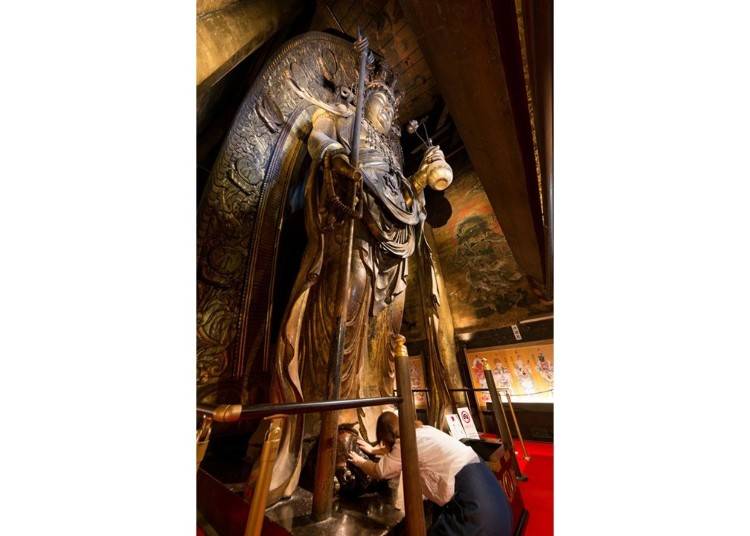
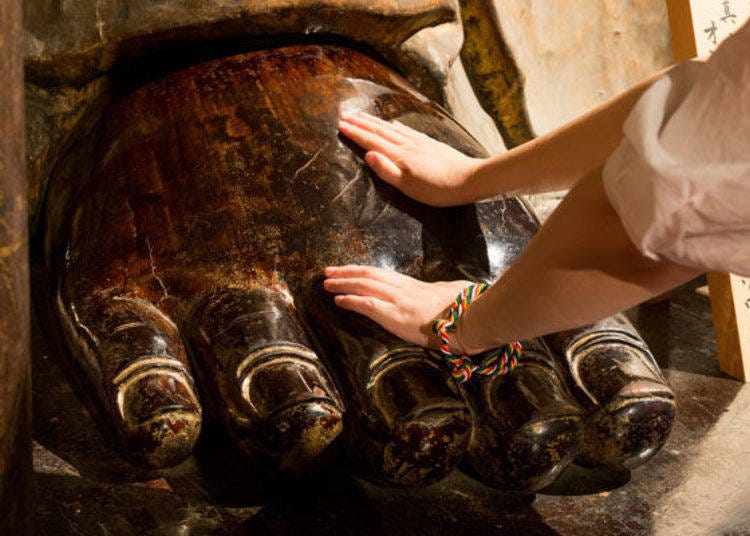
The band on the left wrist of the author shown in the above photo is called Goshikisen which means five colored strands. You can obtain one when entering the hall during special times of worship and it is proof of your connection with Kannon. Apparently it is better to put it on after worshiping and it can be worn on the left arm. If you change the way it is tied, it can also be turned into a netsuke (something like a strap) and other forms.
In that case, the recommended way to do this at Hasedera is to make an agemaki musubi [True Lover's Knot]. This is a decorative knot that has been used since ancient times and is considered to be good as a charm against evil spirits and for self-protection. It is supposedly good for attaching to bags or hanging in cars.

In addition to the main hall, there are other buildings in the precincts such as the Daikokudo, Kaizando, Honhasedera, and Kobo Daishi Miedo. Of these perhaps the most popular is the five-storied pagoda. When it was built in 1954 it was the first pagoda to be built after the Pacific War and is called the Showa no Meito [Famous Showa Pagoda]. It is visible from the stage of the main hall and very impressive when seen up close!

Peony and other types of seasonal flowers are found throughout the temple grounds.
Hasedera Temple is also called the Temple of Flowers because a wide array of colorful flowers bloom here throughout the year. There are more types than I can mention, such as cherry and rhododendron in spring, hydrangea and lotus in summer, autumn leaves and fragrant olive in the fall, and winter-blooming peony, sasanqua camellia, and wintersweet in the winter. The most representative of them all is the peony that blooms in spring.
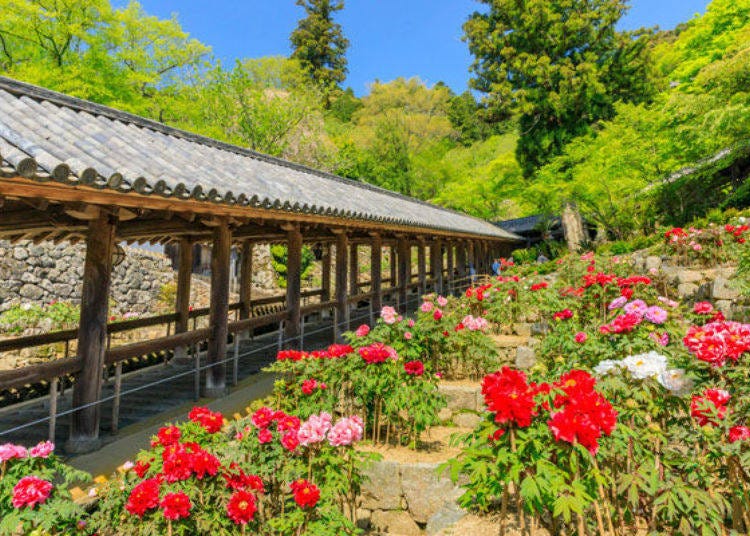
Several events are held during the Peony Festival when the flowers are in full bloom such as the Kenkasai [flower offering festival], tea ceremony, and special sermons, all of which draw large crowds.
The following is a legend associated with the peonies of Hasedera Temple. Mezubunin, a princess of a Tang Emperor, had a face resembling a horse, so for seven days and seven nights she prayed to the Goddess Kannon of Hasedera Temple and miraculously she was transformed into a beauty like no other. In gratitude, she sent peony seedlings to the temple and over the years they spread throughout the temple grounds.
There are also "flower amulets" in the form of these pretty peonies. Coming in a variety of colors, these are said to be good for such things as full health, good looks, and increased good fortune. These are not only good for yourself but also make wonderful souvenirs for family and friends.
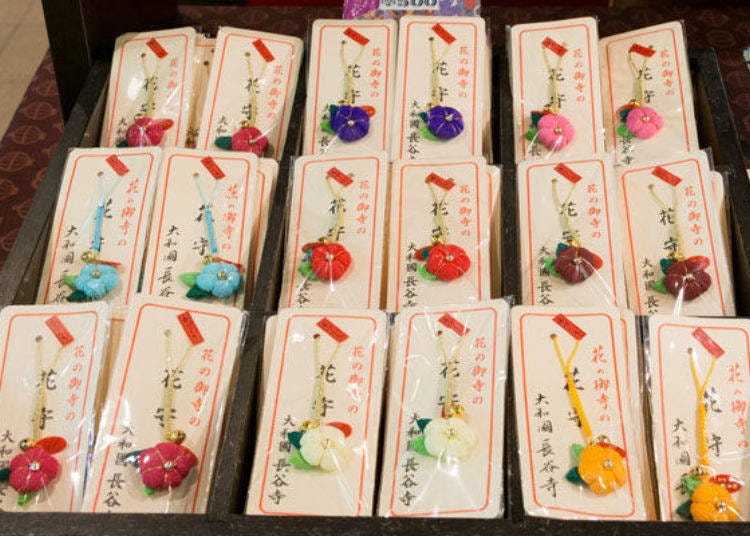
In addition to peonies, there are some other flowers that bloom during the four seasons.
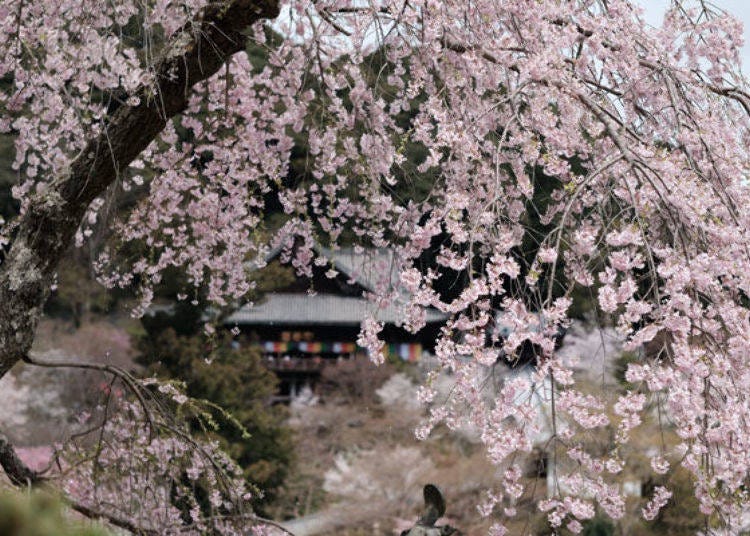


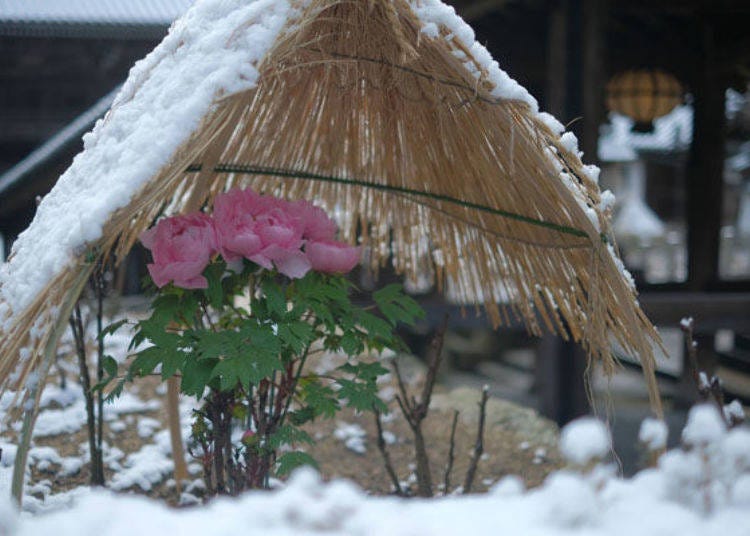
There is also a spot in the precinct grounds where you can enjoy matcha [ceremonial green tea].
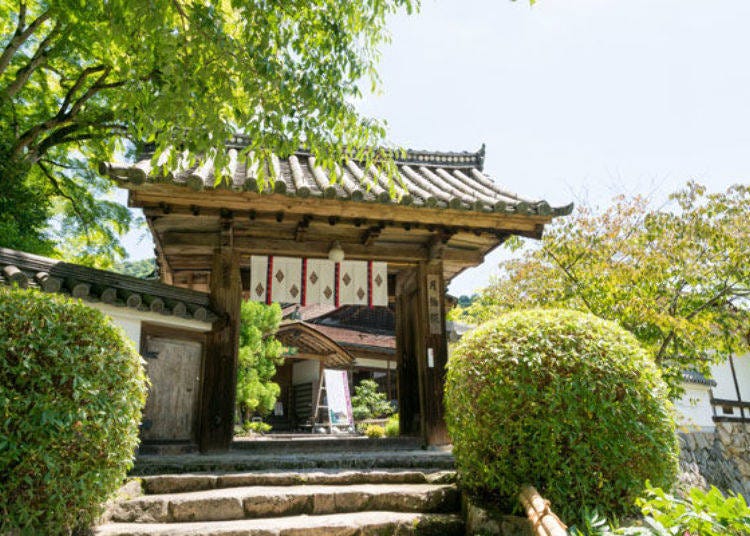
The Gachirinin is a popular place to relax with a cup of matcha or coffee after worshiping.
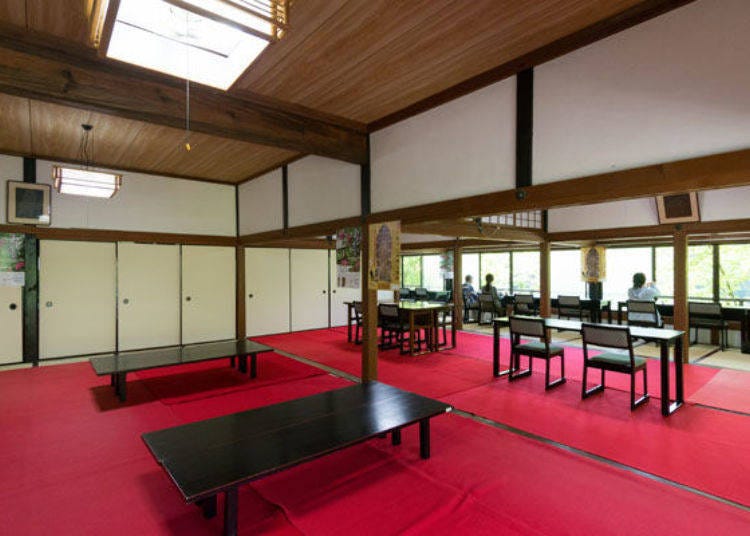
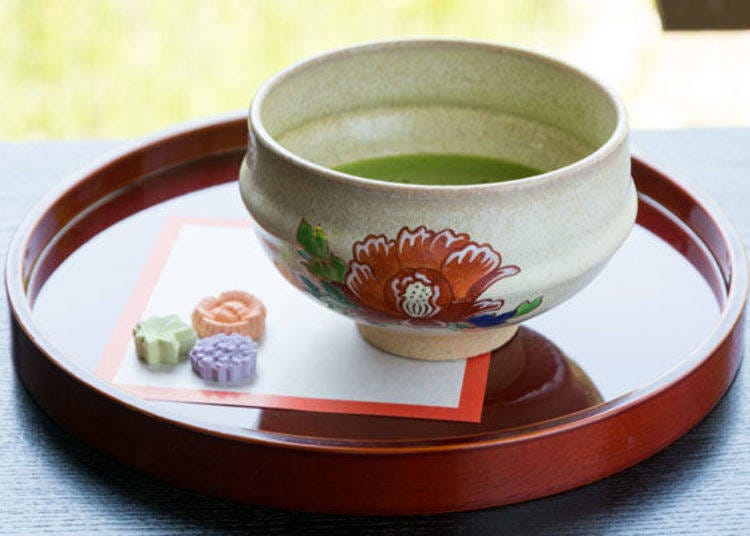
The Chawan Soft, a matcha bowl filled with soft ice cream that will be available only for a limited time, is expected to be offered in spring and autumn.
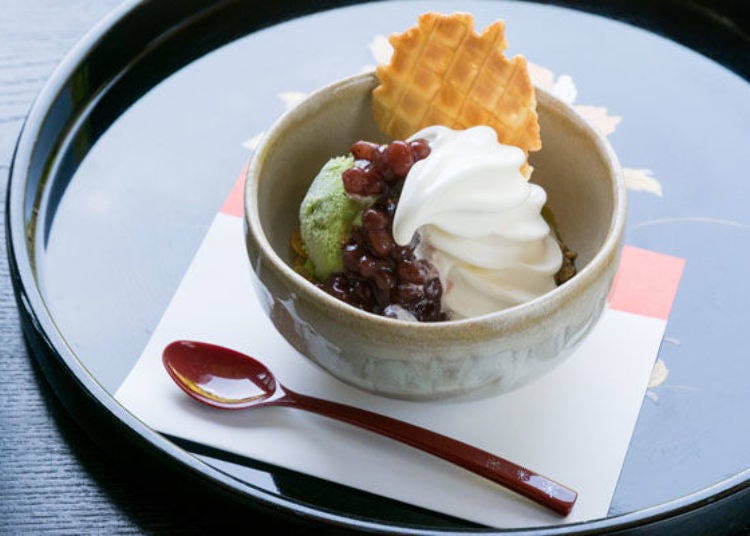
Visit Hasedera Temple and stroll about the broad precinct grounds viewing the flowers in bloom, be one with the Goddess Kannon in the main hall, a national treasure, and obtain a cute amulet that brings beauty. This is a lovely temple that women especially will find very peaceful and energizing.

-

-
Address
731-1 Hatsuse, Sakurai City, Nara Prefecture, 633-0112
View Map -
Nearest Station
Hasedera Station (Kintetsu-osaka Line)
15 minutes on foot
- Phone Number 0744-47-7001
-
Address
731-1 Hatsuse, Sakurai City, Nara Prefecture, 633-0112
Try the famous Kusa Mochi dumplings outside the front gate
Do not forget to buy Kusa Mochi sold outside the front gate before leaving Hasedera for home! Since ancient times the approach to the temple has been lined with many shops selling Kusa Mochi and Sohonpo Shirozakeya is said to be the first shop to do so.
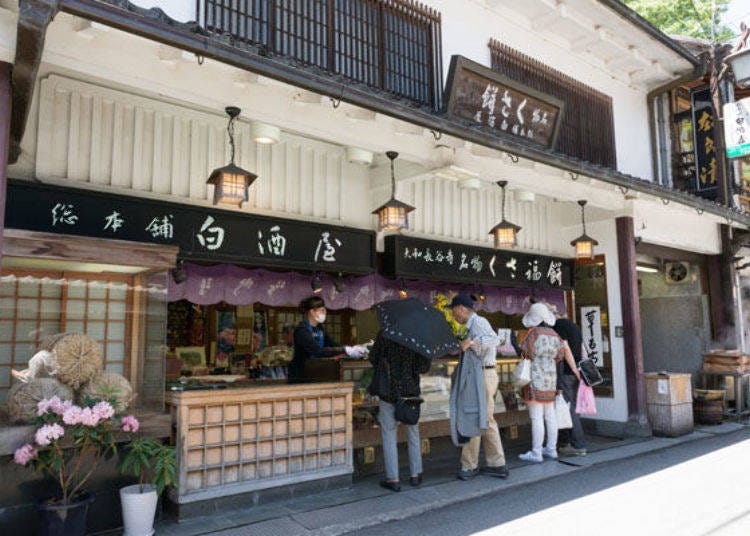
Only new sprouts picked in March of natural mugwort selected from around the country are used in this Kusa Mochi and as a result the fibers in the mugwort are very fine thus resulting in a very smooth texture when eaten. The dough and mugwort are crushed with a pestle by hand creating a sticky consistency full of flavor. Only the finest adzuki red beans produced in Hokkaido are used in the homemade bean jam that is generously wrapped in the dough.
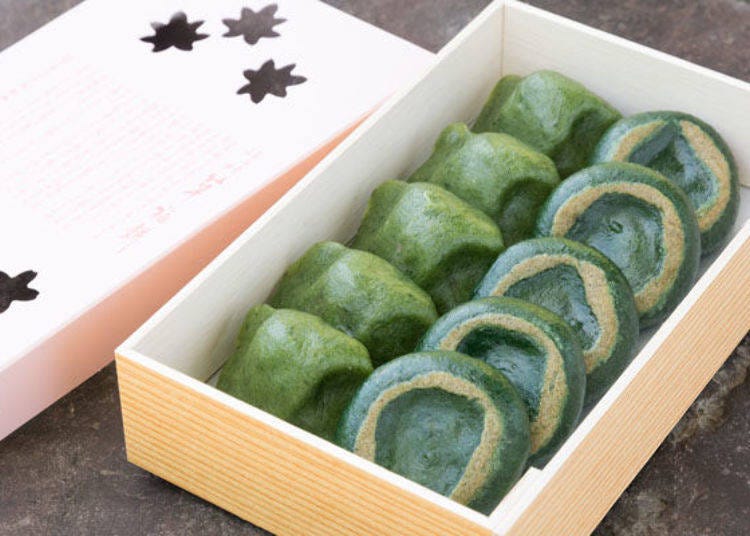
Kusa Fuku Mochi has been handmade in the same way from long ago. Oyaki, on the right, is cooked on an iron skillet giving it a robust flavor and Ao, on the left, is stuffed with sweet bean jam and has a chewy texture. 120 yen each (tax included). Each has a different texture, but both are equally delicious, so buy both! A box of 10 goes for 1,200 yen (tax included).
-
Sohonpo Shirozakeya総本舗白酒屋
- Address 746 Hase, Sakurai City, Nara Prefecture
- Phone Number 0744-47-7988
[Open] 10:00 a.m. ~ 5:00 p.m. ※ 9:00 a.m. ~ 5:00 p.m. during peak seasons
[Closed] Unscheduled * Always open during peak seasons
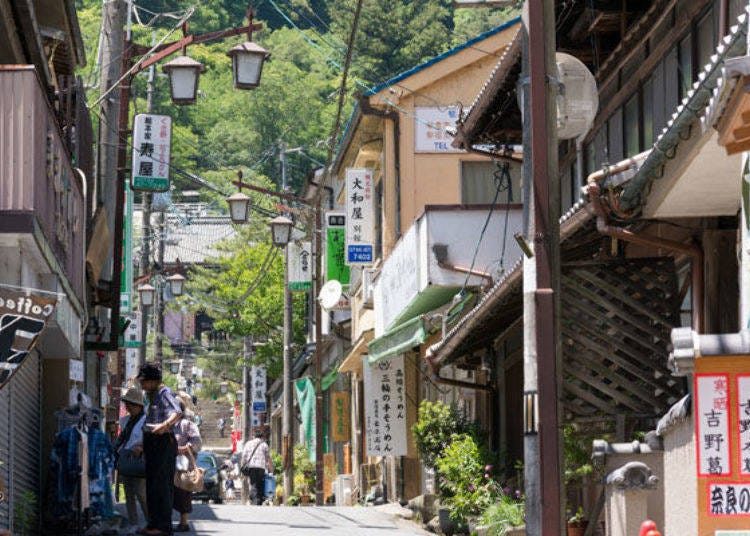
Since ancient times people have made pilgrimages to this site going up the steps of Noboriro to worship the Goddess Kannon, and just thinking of that makes me incredibly happy and grateful. To this day believers still make that journey and I believe it is one you would find most memorable.
- Area
- Category
*Prices and options mentioned are subject to change.
*Unless stated otherwise, all prices include tax.
Popular Tours & Activitiess
Recommended places for you
-
Goods

Yoshida Gennojo-Roho Kyoto Buddhist Altars
Gift Shops
Nijo Castle, Kyoto Imperial Palace
-

Kambei Sannomiyahonten
Yakiniku
Kobe, Sannomiya, Kitano
-

Jukuseiniku-to Namamottsuarera Nikubaru Italian Nikutaria Sannomiya
Izakaya
Kobe, Sannomiya, Kitano
-

Abeno Harukas
Landmarks
Shinsekai, Tennouji, Tsuruhashi
-

ISHIDAYA Hanare
Yakiniku
Kobe, Sannomiya, Kitano
-

Kanzenkoshitsuyakinikutabehodai Gyugyu Paradise Sannomiya
Yakiniku
Kobe, Sannomiya, Kitano
-

A First Look at NEMU RESORT’s 2026 Grand Renewal in Ise-Shima: A Resort Shaped by Village, Sea, and Forest
by: Guest Contributor
-
Ad

Recharge and Relax with a Healing Getaway at Kamenoi Hotel Toba
-
Ad

Discover Timeless Beauty: Kimono-en, a Web Magazine Exploring the Spirit of Kimono
-

Everything You Need to Know About teamLab Biovortex Kyoto (2025 Insider Guide)
by: Wemmy Chau
-
Ad

Experiencing Manga as Culture, Not Just Reading It: Expo 2025 with Rumiko Takahashi
-

November Events in Kansai: Fun Festivals, Food, and Things to Do in Kyoto & Osaka
Inspiration for Accommodations
-

Spacious Family Hotel in Namba: 20 Comfortable Stays for Family Fun
-

Charming Hotels to Enjoy the Spectacular Views of Arashiyama's Autumn Leaves from Your Room
-

Experience Stunning Views of Osaka Castle from Private Spaces: Top Hotels Near Osaka Castle
-

Recommended by Visitors! Arashiyama's Best-Rated Hotels
-

Family-Friendly Universal Studios Japan Hotel with Excellent Access
-

Enjoy a Comfortable Stay in Osaka! 10 Hotels with Convenient Airport Shuttle Services
-

Top 10 Recommended Hotels Near Namba Station with Great Access
-

Enjoy Night Views from Your Room! Recommended Hotels in Namba Area
-

Inside Kyoto's Spectacular Sanjusangen-do Temple with 1,000 Gold Statues
-

10 Important Japanese Phrases to Know Before You Enter a Japanese Convenience Store!
by: Teni Wada
-

Michelin Star Restaurants & More: 3 Best Okonomiyaki Shops in Dotonbori Osaka
-

Inside Tenryuji Temple: Most Popular Attraction in Kyoto's Arashiyama Area
by: WESTPLAN
-

Toji Temple: Exploring Around the Famous Kyoto Pagoda in Autumn
-

3 Best Hotels in Kobe, Japan with Amazing Views of Kobe Bay!
- #best gourmet Osaka
- #things to do Osaka
- #what to do in kyoto
- #what to bring to japan
- #best gourmet Kyoto
- #new years in Osaka
- #what to buy in nanba
- #Visiting Osaka
- #onsen tattoo friendly arima
- #daiso
- #Visiting Kyoto
- #best japanese soft drinks
- #japanese fashion culture
- #japanese convenience store snacks
- #japanese nail trends













